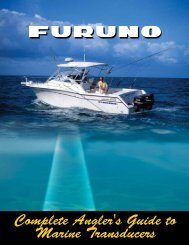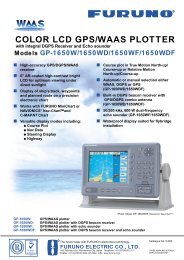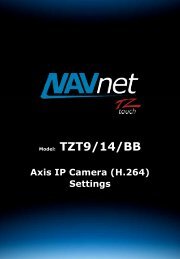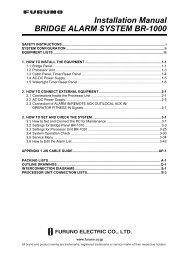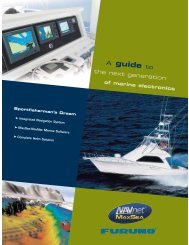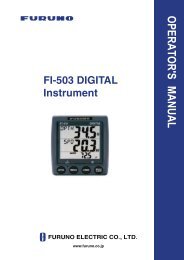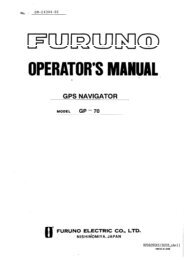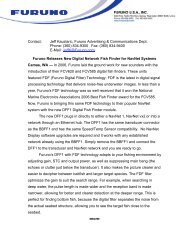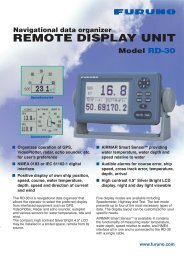Installation Instructions - Airmar Technology Corporation
Installation Instructions - Airmar Technology Corporation
Installation Instructions - Airmar Technology Corporation
You also want an ePaper? Increase the reach of your titles
YUMPU automatically turns print PDFs into web optimized ePapers that Google loves.
6. Sand and clean the area around the hole, inside and outside, to<br />
ensure that the sealant will adhere properly to the hull. If there is<br />
any petroleum residue inside the hull, remove it with either mild<br />
household detergent or a weak solvent (alcohol) before sanding.<br />
7. Proceed with “Bedding” and “Installing” (see pages 2 and 3).<br />
Checking for Leaks<br />
Warning: DO NOT leave the boat in the water unchecked for<br />
several days.<br />
When the boat is placed in the water, immediately check the<br />
thru-hull transducer for leaks. Note that very small leaks may not<br />
be readily observed. Do not to leave the boat in the water for more<br />
than 3 hours before checking it again. If there is a small leak,<br />
there may be considerable bilge water accumulation after 24<br />
hours. If a leak is observed, repeat “Bedding” and “Installing”<br />
immediately (see pages 2 and 3).<br />
Operation & Maintenance<br />
DT800V only—How the Valve Works<br />
WARNING: THE VALVE IS NOT A WATERTIGHT SEAL!<br />
Always use the insert or the blanking plug secured with the<br />
safety wire for a watertight seal.<br />
The DT800V incorporates a self-closing valve which minimizes<br />
the flow of water into the boat when the insert is removed. The<br />
curved flap valve is activated by both a spring and water pressure.<br />
Water pushes the flap valve upward to block the opening, so there<br />
is no gush of water into the boat.<br />
Using the Blanking Plug<br />
To protect the insert, use the blanking plug:<br />
• When the boat will be kept in salt water for more than a week.<br />
• When the boat will be removed from the water.<br />
• When aquatic growth buildup is suspected due to inaccurate<br />
readings from the instrument.<br />
4<br />
Warning: The O-rings must be intact and well lubricated to<br />
make a watertight seal.<br />
1. On the blanking plug, inspect the O-rings (replace if necessary)<br />
and lubricate them with the silicone lubricant supplied or<br />
petroleum jelly (Vaseline®) (see Figure 5).<br />
2. Remove the insert from the housing by removing the safety wire<br />
and unscrewing the cap nut (see Figure 3). This will jack out<br />
the insert.<br />
DT800—With the blanking plug ready in one hand, pull the<br />
insert most of the way out. Remove the insert and rapidly<br />
replace it with the blanking plug. With practice, only 250ml<br />
(10oz.) of water will enter the boat.<br />
DT800V—Grasp the insert and remove it with a slow pulling<br />
motion. Slide the blanking plug into the housing.<br />
Note: In the very unlikely event that the valve breaks, replace<br />
the housing the next time the boat is hauled.<br />
Warning: Be sure the blanking plug is fully inserted into the<br />
housing, and the cap nut is screwed on completely.<br />
3. Screw the cap nut several turns until the threads are engaged.<br />
Continue to tighten the cap nut. HAND-TIGHTEN only.<br />
Do not over-tighten.<br />
AIRMAR ®<br />
TECHNOLOGY CORPORATION<br />
insert<br />
WARNING: Always attach the safety wire to prevent the<br />
blanking plug from backing out in the unlikely event that the<br />
insert nut and/or cap nut fails or is screwed on incorrectly.<br />
4. Reattach the safety wire.<br />
Servicing the Insert<br />
Aquatic growth can accumulate rapidly on the transducer’s<br />
surface reducing performance within weeks. Clean the insert with<br />
a Scotch-Brite® scour pad and mild household detergent, being<br />
careful to avoid scratching the depth transducer. If fouling is<br />
severe, lightly wet sand it with fine grade wet/dry paper.<br />
O-rings must be free of abrasions and cuts to ensure a watertight<br />
seal. Install two O-rings near the bottom of the insert<br />
(see Figure 5). Place the remaining two O-rings in similar<br />
positions on the blanking plug.<br />
Winterizing<br />
After the boat has been hauled for winter storage, remove the<br />
blanking plug to let the water drain away before reinserting it. This<br />
will prevent any water from freezing around the blanking plug and<br />
possibly cracking it.<br />
Replacement Parts<br />
Lost, broken, or worn parts should be replace immediately. Obtain<br />
parts from your instrument manufacturer or marine dealer.<br />
Gemeco (USA) Tel: 843.394.3565<br />
Fax: 843.394.3736<br />
email: sales@gemeco.com<br />
<strong>Airmar</strong> Europe Tel: +45.45.81.04.18<br />
Fax: +45.45.81.04.93<br />
email: sales@airmareurope.com<br />
If you have purchased a plastic housing and have a wood hull or<br />
desire greater strength, purchase an <strong>Airmar</strong> metal housing.<br />
Hull Nut or<br />
Isolation Ring<br />
04-004 (plastic)<br />
02-030 (bronze)<br />
02-570-01 (stainless steel)<br />
04-186-1 (isolation ring)<br />
Housing, Nut & Washer<br />
NO VALVE<br />
33-100 (bronze, low profile, B17)<br />
33-224-01 (bronze, counterbore, B21)<br />
33-091-01 (bronze, flush, B119)<br />
33-495-01 (stainless steel, low profile, SS577)<br />
O-rings 33-519-01<br />
Blanking Plug 33-538-01<br />
Housing with Valve, Nut & Washer 33-510-01 (plastic, low profile, P617)<br />
Transducer Replacement—The information needed to order a<br />
replacement <strong>Airmar</strong> multisensor is printed on the cable tag. Do<br />
not remove this tag. When ordering, specify the part number,<br />
date, and frequency in kHz. For convenient reference, record this<br />
information on the top of page one.<br />
35 Meadowbrook Drive, Milford, New Hampshire 03055-4613, USA<br />
■ www.airmar.com<br />
Copyright © 2003, 2005, 2006 <strong>Airmar</strong> <strong>Technology</strong> Corp. All rights reserved.<br />
small<br />
O-ring(s)<br />
Figure 5. Replacing the O-rings<br />
Copyright © 2005 <strong>Airmar</strong> <strong>Technology</strong> Corp.<br />
blanking plug



